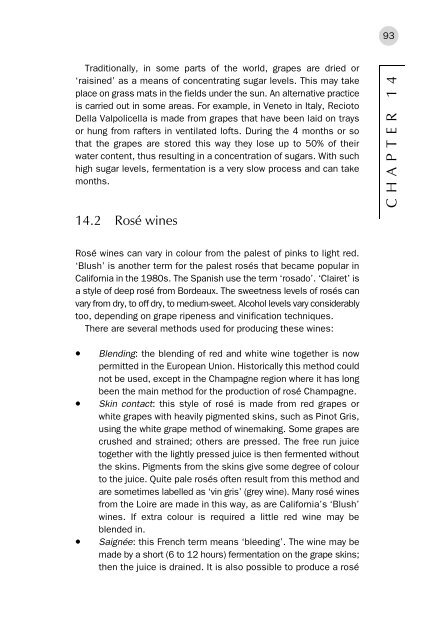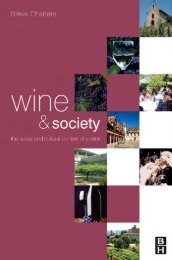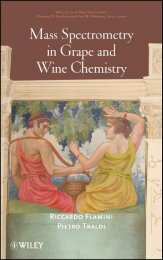Wine Production : Vine to Bottle - Vinum Vine
Wine Production : Vine to Bottle - Vinum Vine
Wine Production : Vine to Bottle - Vinum Vine
Create successful ePaper yourself
Turn your PDF publications into a flip-book with our unique Google optimized e-Paper software.
93<br />
Traditionally, in some parts of the world, grapes are dried or<br />
‘raisined’ as a means of concentrating sugar levels. This may take<br />
place on grass mats in the fields under the sun. An alternative practice<br />
is carried out in some areas. For example, in Vene<strong>to</strong> in Italy, Recio<strong>to</strong><br />
Della Valpolicella is made from grapes that have been laid on trays<br />
or hung from rafters in ventilated lofts. During the 4 months or so<br />
that the grapes are s<strong>to</strong>red this way they lose up <strong>to</strong> 50% of their<br />
water content, thus resulting in a concentration of sugars. With such<br />
high sugar levels, fermentation is a very slow process and can take<br />
months.<br />
14.2 Rosé wines<br />
CHAPTER 14<br />
Rosé wines can vary in colour from the palest of pinks <strong>to</strong> light red.<br />
‘Blush’ is another term for the palest rosés that became popular in<br />
California in the 1980s. The Spanish use the term ‘rosado’. ‘Clairet’ is<br />
a style of deep rosé from Bordeaux. The sweetness levels of rosés can<br />
vary from dry, <strong>to</strong> off dry, <strong>to</strong> medium-sweet. Alcohol levels vary considerably<br />
<strong>to</strong>o, depending on grape ripeness and vinification techniques.<br />
There are several methods used for producing these wines:<br />
• Blending: the blending of red and white wine <strong>to</strong>gether is now<br />
permitted in the European Union. His<strong>to</strong>rically this method could<br />
not be used, except in the Champagne region where it has long<br />
been the main method for the production of rosé Champagne.<br />
• Skin contact: this style of rosé is made from red grapes or<br />
white grapes with heavily pigmented skins, such as Pinot Gris,<br />
using the white grape method of winemaking. Some grapes are<br />
crushed and strained; others are pressed. The free run juice<br />
<strong>to</strong>gether with the lightly pressed juice is then fermented without<br />
the skins. Pigments from the skins give some degree of colour<br />
<strong>to</strong> the juice. Quite pale rosés often result from this method and<br />
are sometimes labelled as ‘vin gris’ (grey wine). Many rosé wines<br />
from the Loire are made in this way, as are California’s ‘Blush’<br />
wines. If extra colour is required a little red wine may be<br />
blended in.<br />
• Saignée: this French term means ‘bleeding’. The wine may be<br />
made by a short (6 <strong>to</strong> 12 hours) fermentation on the grape skins;<br />
then the juice is drained. It is also possible <strong>to</strong> produce a rosé
















